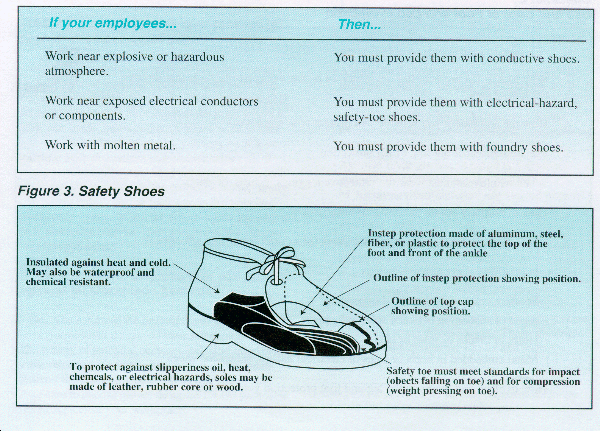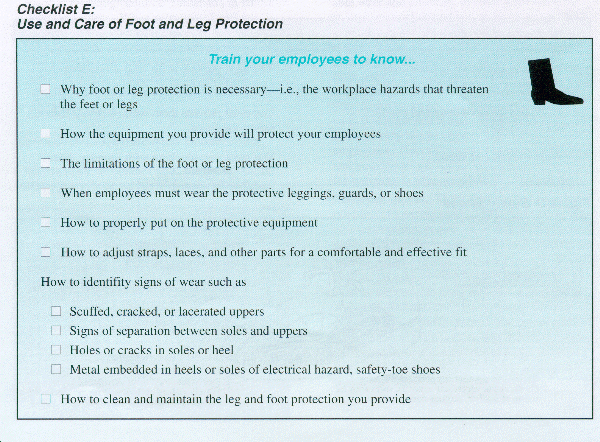
 Assessing the Need
Assessing the Need
for Personal Protective Equipment:
A Guide for Small Business Employers
Small Business Safety Management Series
U.S. Department of Labor
Occupational Safety and Health Administration
OSHA 3151
1997
When must I provide foot and leg protection?
You must provide foot and leg protection if your workplace hazard assessment reveals potential dangers to these parts of the body. Some of the potential hazards you might identify include the following:
Heavy objects such as barrels or tools that might roll onto or fall on employees' feet.
Sharp objects such as nails or spikes that might pierce the soles or uppers of ordinary shoes.
Molten metal that might splash on feet or legs
Hot or wet surfaces.
Slippery surfaces.
What are the types of protection and where do I use them?
The type of foot and leg protection you provide your employees will depend upon the specific workplace hazards you identify and the specific parts of the feet or legs exposed to potential injury. Safety footwear must meet minimum compression and impact performance standards and testing requirements established by ANSI. Protective footwear purchased after July 5, 1994, must meet the requirements of ANSI Z41-1991.(8) Protective footwear bought before that date must comply with ANSI Z41-1967. Foot and leg protection choices includes the following:
Leggings. Use these to protect the lower legs and feet from heat hazards, like molten metal or welding sparks. Safety snaps allow leggings to be removed quickly.
Metatarsal guards. Made of aluminum, steel, fiber, or plastic, these guards maybe strapped to the outside of shoes to protect the instep area from impact and compression.
Toe guards. Toe guards may be made of steel, aluminum, or plastic. They fit over the toes of regular shoes. These guards protect only the toes from impact and compression hazards.
Combination foot and shin guards. These guards may be used in combination with toe guards when greater protection is needed.
Safety shoes. These sturdy shoes have impact-resistant toes and heat-resistant soles that protect against hot work surfaces common in roofing, paving, and hot metal industries. The metal insoles of some safety shoes protect against puncture wounds. Safety shoes may also be designed to be electrically conductive to prevent the buildup of static electricity in areas with the potential for explosive atmospheres, or nonconductive to protect workers from workplace electrical hazards.

What should I look for when choosing safety shoes for my employees?
Generally, safety shoes must be sturdy and must have impact-resistant safety toes, instep protection, and heat-resistant soles (see Figure 3). All safety shoes must comply with the ANSI standard(s) mentioned above. In addition, depending on the types of worker exposures, you may need to provide specially designed safety shoes such as conductive or electrical-hazard safety shoes.
Conductive Shoes: Electrically conductive shoes protect against the buildup of static electricity. Essentially, these shoes ground the employees wearing them. Employees working in explosive and hazardous locations such as explosives manufacturing facilities or grain elevators must wear conductive shoes to reduce the risk of static electricity buildup on an employee's body that could produce a spark and cause an explosion or fire. During training, employees must be instructed not to use foot powder or wear socks made of silk, wool, or nylon with conductive shoes. Foot powder insulates and retards the conductive ability of the shoes. Silk, wool, and nylon produce static electricity.
Conductive shoes are not general-purpose shoes and must be removed upon completion of the tasks for which they are required. Employees exposed to electrical hazards must never wear conductive shoes.

Electrical hazard, safety-toe shoes are nonconductive and will prevent your employees' feet from completing an electrical circuit to the ground. They can protect employees against open circuits of up to 600 volts in dry conditions. Electrical hazard, safety-toe shoes should be used in conjunction with other insulating equipment and precautions to reduce or eliminate the potential for your employees' bodies or parts of their bodies to provide a path for hazardous electrical energy. Note: Nonconductive footwear must not be used in explosive or hazardous locations; in such locations, electrically conductive shoes are required.
Train your employees to recognize that the insulating protection of electrical hazard, safety-toe shoes may be compromised if
Foundry Shoes: In addition to insulating your employees' feet from the extreme heat of molten metal, foundry shoes prohibit hot metal from lodging in shoe eyelets, tongues, or other parts. These snug-fitting leather or leather-substitute shoes have leather or rubber soles and rubber heels. In addition, all foundry shoes must have built-in safety toes.
Once I have selected equipment to protect my employees' feet and legs, how do I make sure they use it properly?
Train your employees to use the protective footwear. Checklist E will help you instruct your employees to use and care for the foot and leg protection you provide.
